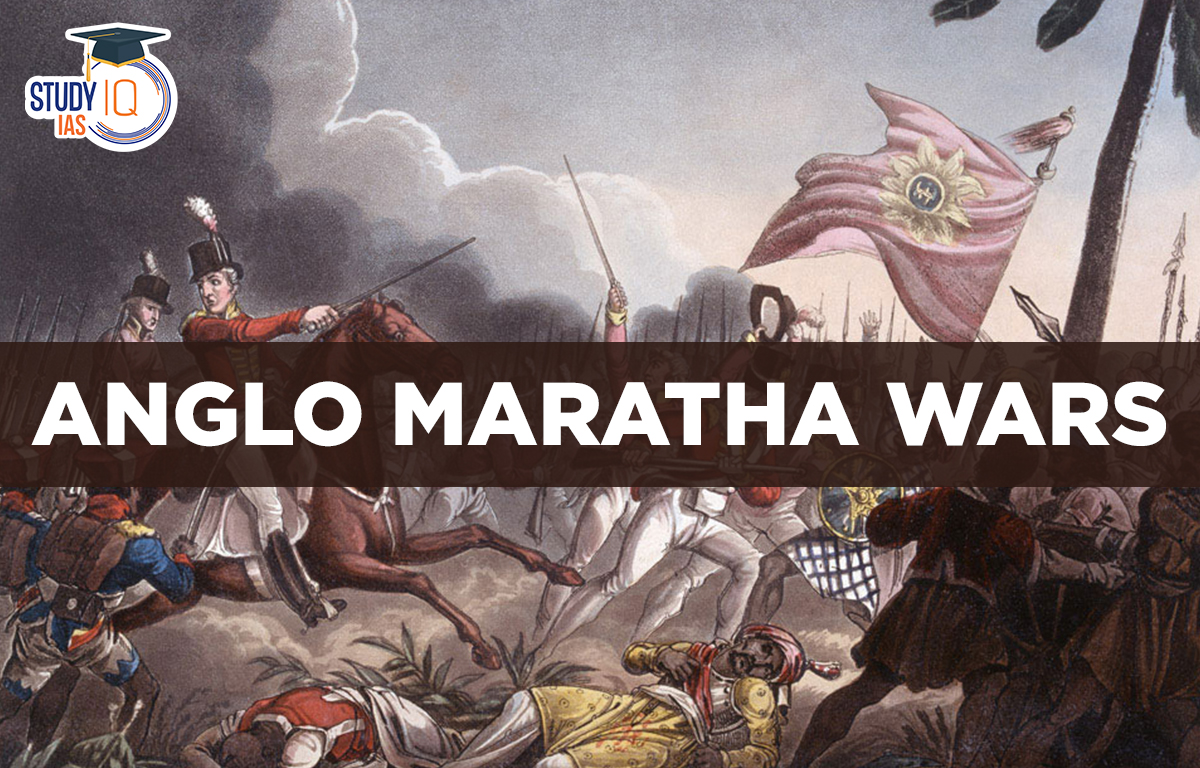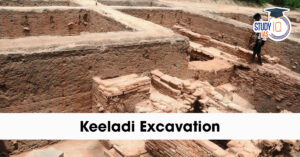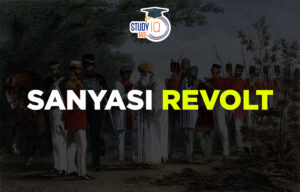Table of Contents
Anglo Maratha Wars
The Anglo-Maratha War (1775–1782) was the first of three Anglo-Maratha Wars fought in India between the Maratha Empire and the British East India Company. The Surat Treaty signaled the start of the conflict, while the Salbai Treaty marked its end. British loss and the restoration of both sides’ pre-war positions were the outcomes of the struggle between Surat and Pune Kingdom.
First President and Governor-General of the East India Company in India, Warren Hastings, decided against attacking right away. You will learn about the Anglo-Maratha War (1775-82) in this article, which will help you prepare for the UPSC Civil Service Exam.
Read about: Battle of Buxar
Anglo-Maratha Wars History
Balaji Bajirao, the Maratha Empire’s third Peshwa, passed away in 1761 as a result of the stress of losing the third battle of Panipat. After his passing, his son Madhavrao took over and was successful in recovering part of the Maratha Empire’s lost territory in the Battle of Panipat. There was a fierce struggle for control of the throne in the Maratha Empire following Madhavrao’s passing.
As both Narayan Rao and his uncle want to become the Peshwa, there was a perpetual rivalry between them. However, Narayan Rao turned as a Peshwa, and his uncle made an attempt to enlist the British. Raghunath Rao returned the Bassein to the British after the Surat Agreement was reached in 1775.
Peshwa Narayan Rao was attacked by the British army led by Raghunath Rao, who engaged him in combat and prevailed. The Warren Hastings-era pact was terminated by the British Calcutta Council, and a new treaty between the Calcutta Council and the Maratha Minister was signed in 1776.
A French port was authorised on the West Coast by Nana Fadnavis in 1777 as a condition of his agreement with the Calcutta Council. The Marathas, under the leadership of Mahadji Shinde, decisively won the battle of Vadgaon near Pune as a result of the British sending their forces to Pune and holding them there. The Vadgaon Agreement was made between the British and the Indians after the English lost the war in 1779.
Read about: Carnatic War
First Anglo-Maratha War
The first Anglo-Maratha War was the first of three conflicts between the Maratha Empire and Great Britain that took place in India. The conflict, which had begun with the Treaty of Surat, came to a close with the Salbai Treaty. Even though Raghunath Rao was not a legal descendant, Madhavrao Peshwa’s death in 1772 and Raghunath Rao’s murder of his nephew as part of a scheme declared Raghunath the Peshwa.
Nana Phadnis and 12 other Maratha chiefs supported this choice when it came time to name an infant, Narayana Rao’s child, the following year. Raghunath Rao, who was reluctant to give up his position of power, enlisted the help of the British in Bombay and signed the Surat Treaty on March 7, 1777. Raghunath Rao transferred the Salsette and Bassein regions as well as a share of the revenue from the Surat and Bharuch districts to the British in accordance with the conditions of the treaty.
1. First Anglo-Maratha War Courses
Raghunath Rao received 2500 soldiers from the British in return. The British Calcutta Council disapproved of the Surat treaty and sent Colonel Uttan to Pune to get it annulled on the opposite side of India. In 1777, Nana Fadnavis broke the deal. The British responded by sending troops in Pune’s direction. The Maratha cavalry encircled the British and used the “scorched earth” tactic to attack them.
They were forced to evacuate to Wadgao when the British began to withdraw to Talegaon. With the signing of the Wadgao Treaty, which obliged the Bombay government to relinquish all territory it had gained since 1775, the British ultimately gave up. The British governor-general in Bengal, Warren Hastings, rejected this agreement and sent an army. A second Bengali force led by Captain Popham captured Gwalior in August 1780. Yet another group led by Hastings pursued Mahadaji Shinde.
2. First Anglo-Maratha War Result
Shinde was ultimately defeated by the British at Sikri in February 1781. In response to the defeat, Shinde proposed the Salbai Treaty, which would have recognised the young Madhava Rao as the Peshwa and given Raghunath Rao a pension. Hastings and Phadnis approved this treaty in June 1782 after it was signed in May 1782.
Read about: Battle of Plassey
Second Anglo-Maratha War
During the second Anglo-Maratha War, the United Kingdom and the Maratha Empire in India battled once more (1803 to 1805). In support of Bajirao, the British put down the Maratha insurgents on September 23, 1803, and then reinstated him as ruler in accordance with the Bassein Treaty. Sir Arthur Wellesley overthrew the rebellious Bhosale monarchs of Nagpur and Berar, as well as the Sindhia kings of Gwalior.
The Holkar kings of Indore were defeated when they eventually joined the war. The British acquired control of Orissa as well as parts of western Gujarat and Bundelkhand from the Marathas when the peace treaty was signed in 1805, however they kept free reign over the majority of central India. Rajasthan was still mostly ruled and dominated by Sindhia maharajas.
1. Second Anglo-Maratha War Courses
The Peshwa brutally killed Vithuji Holkar, Yashwantrao Holkar’s brother, on April 1st, 1801. As the turmoil persisted, Yashwant decisively defeated the Peshwa and Scindia troops at Hadapsar near Poona on October 25, 1802, installing Vinayakrao, son of Amritrao, on the Peshwa’s throne. Bajirao II fled to Bassein, where on December 31, 1802, he signed a treaty with the English.
The Peshwa agreed to the following conditions in the Bassein Treaty (1802). To receive a local infantry (of at least 6,000 soldiers) from the Company, permanently stationed in his territory, with the standard proportion of field artillery and European artillery personnel attached. In the Courses of war agreement was made to abandon Surat, to transfer lands worth Rs. 26 lakh to the Company, and to renounce any rights to chauth on the Nizam’s domain.
the Courses of war agreement was made to submit his connections with foreign governments to English control and to submit all conflicts with the Nizam or the Gaekwad to arbitration by the Company. He also agreed not to hire any Europeans from a country at war with the English. When the Peshwa opted to join the subsidiary alliance, Scindia and Bhonsle attempted to preserve Maratha independence.
However, the combined forces of Scindia and Bhonsle were crushed by the English army under the command of Arthur Wellesley, forcing them to ratify separate secondary treaties with the English. In 1804 Yashwantrao Holkar tried to put up a coalition of Indian kings to fight the English. His effort, though, was a disaster. The British defeated the Marathas, forced them into vassalage, and split them up.
2. Second Anglo-Maratha War Result
In these battles, the Maratha army was completely defeated by the British. The British were given the territory of Rohtak, Ganga-Yamuna Doab, Gurgaon, the Delhi-Agra region, Broach, numerous Gujarati districts, portions of Bundelkhand, and the Ahmednagar fort when the Scindias signed the Surji-Anjangaon Treaty in 1803.
The Treaty of Deogaon, which was signed by the Bhonsles in 1803, gave the English control over Cuttack, Balasore, and the area west of the Wardha River. In 1805, the Holkars agreed to the Treaty of Rajghat, which gave the British Tonk, Bundi, and Rampura. The British took over large portions of central India as a result of the conflict.
Third Anglo-Maratha War
The British were pitted against the Maratha Empire in India during the Third Anglo-Maratha War, which lasted from 1817 to 1818. The UK ultimately acquired control of the majority of India. Lord Hastings, the British governor general, launched an invasion into Maratha territory to begin operations against Pindare robber clans.
British diplomacy was able to convince him to remain neutral despite the soldiers of the Gwalior-based Sindhia rising up in opposition to the British and despite the British losing control of Rajasthan. The majority of his province was under the Bombay presidency. Despite this, the Maharaja of Satara remained in power until 1848, when the Bombay state acquired his princely territory.
British India received the Saugor and Nerbudda Territories, which contained the Peshwa’s territories in Bundelkhand in the northern Nagpur Bhosale realm. By becoming princely states, the Maratha kingdoms of Indore, Gwalior, Nagpur, and Jhansi consented to British administration. After the third Anglo-Maratha War, the British practically held total control over modern-day India South of the Sutlej river.
1. Third Anglo-Maratha War Courses
The British Residency was attacked by the Peshwa at Poona. When Nagpur’s Appa Sahib attacked the Nagpur home, the Holkar started preparing for battle. However, the Marathas had virtually all of the components needed for a power to flourish lost at that point.
The political and administrative environments of every Maratha state were disorganised and ineffectual. After Jaswantrao Holkar passed away, Tulsi Bai, the Holkars’ preferred mistress, took over control of Poona. Even though she was a clever and learned woman, the influence of some useless men like Balram Seth and Amir Khan prevented her from successfully ruling the country.
Both the Scindia in Gwalior and the Bhonsle in Nagpur were in decline. Therefore, the English were able to stop the Peshwa from once again exercising power over the Maratha confederacy by retaliating harshly.
2. Third Anglo-Maratha War Result
At Khirki, Holkar was defeated in Mahidpur while Bhonsle was defeated in Sitabuldi. There were several important treaties signed. In June 1817, the Treaty of Poona with Peshwa was signed. November 1817: Gwalior Treaty with Scindia. In January 1818, Mandsaur and Holkar signed the Treaty of Mandsaur. In June 1818, the Peshwa finally submitted, and the Maratha Confederacy was dissolved.
The system of peshwas was gradually abandoned. Peshwa Bajirao enlisted as a British retainer at Bithur, close to Kanpur. A direct descendent of Shivaji named Pratap Singh was made the ruler of Satara, a small principality formed from the Peshwa’s territories.
Anglo-Maratha War UPSC
This article has complete detail about the Anglo- Maratha war from First to third Anglo- Maratha Wars. It has complete detail about the wars for the preparation of UPSC Examination. Candidate will find all the detail in this article about Anglo- Maratha War.


 Maharashtra’s Mendrachi Vancharai Syst...
Maharashtra’s Mendrachi Vancharai Syst...
 Keeladi Excavation: Uncovering the Ancie...
Keeladi Excavation: Uncovering the Ancie...
 Sanyasi Revolt, Objectives, History, Rea...
Sanyasi Revolt, Objectives, History, Rea...





















